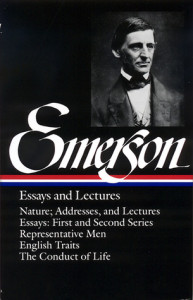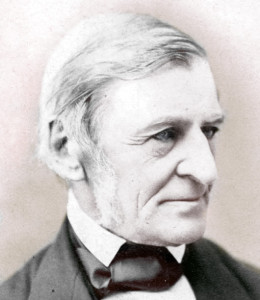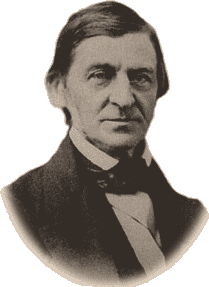Ralph Waldo Emerson (25 May 1803 – 27 Apr 1882)
BIOGRAPHIES, 24 May 2021
American Transcendentalism Web – TRANSCEND Media Service
Born in 1803 to a conservative Unitarian minister, from a long line of ministers, and a quietly devout mother, Waldo–who dropped the “Ralph” in college–was a middle son of whom relatively little was expected. His father died when he was eight, the first of many premature deaths which would shape his life–all three brothers, his first wife at 20, and his older son at 5. Perhaps the most powerful personal influence on him for years was his intellectual, eccentric, and death-obsessed Puritanical aunt, Mary Moody Emerson. Yet Emerson often confessed to an innate optimism, even occasional “silliness.”
His undergraduate career at Harvard was not illustrious, and his studies at the Harvard Divinity School were truncated by vision problems, but he was ordained a minister of the Second Church in Boston, shortly before marrying Ellen Tucker in 1829. He resigned in 1832 after her death from tuberculosis, troubled by theological doctrines such as the Lord’s Supper, and traveled extensively in Europe, returning to begin a career of lecturing. In 1835 he married Lydia Jackson; they lived in Concord and had four children while he settled into his life of conversations, reading and writing, and lecturing, which furnished a comfortable income.
The Emerson house was a busy one, with friends like Elizabeth Hoar, Margaret Fuller, and Henry Thoreau staying for months to help out and talk. He, Bronson Alcott, and George Ripley decided to begin a magazine, The Dial, with Margaret Fuller editing, in 1840; Emerson would edit the final two years, ending in 1844, and he wrote essays for many issues. His Essays (first series) were published in 1841.
 Meanwhile, tragedy struck with the sudden death of his five-year old son Waldo in 1842, soon after the death of John Thoreau from lockjaw, and a darker, tougher strain appears in Emerson’s writing, beginning with his memorializing poem, “Threnody.” But Emerson pulled himself together to give a series of lectures in New York and in 1844 he had a new volume of essays prepared. He began planning a series of lectures on great men and publication of his poems in 1846, while speaking out against the annexation of Texas and reading deeply in texts of Persian and Indic wisdom.
Meanwhile, tragedy struck with the sudden death of his five-year old son Waldo in 1842, soon after the death of John Thoreau from lockjaw, and a darker, tougher strain appears in Emerson’s writing, beginning with his memorializing poem, “Threnody.” But Emerson pulled himself together to give a series of lectures in New York and in 1844 he had a new volume of essays prepared. He began planning a series of lectures on great men and publication of his poems in 1846, while speaking out against the annexation of Texas and reading deeply in texts of Persian and Indic wisdom.
In 1845 he began extensive lecturing on “the uses of great men,” a series that culminated with the 1850 publication of Representative Men; by that year he was giving as many as 80 lectures a year. Through a career of 40 years, he gave about 1500 public lectures, traveling as far as California and Canada but generally staying in Massachusetts. His audiences were captivated by his speaking style, even if they didn’t always follow the subtleties of his arguments.
In 1847 Emerson travelled to England, noticing in particular the industrialization and the chasm between upper and lower classes. When he returned to Concord nine months later, he had a new approach to English culture, which he expressed in his lectures on the “Natural History of Intellect” and his 1856 book, English Traits.
In 1851 he began a series of lecture which would become The Conduct of Life, published in 1860. He was vigorous in middle age, traveling frequently, but was increasingly aware of his limits and failing energy. He had become quite famous, a major figure in the American literary landscape, a celebrity which brought both adulation and satire. He had been a profound inspiration for many writers, especially Henry Thoreau and Walt Whitman. He continued his speeches against slavery, but never with the fire of Theodore Parker. In 1857 he wrote an essay on “Memory” but ironically, in his later years, his own memory would falter, especially after his beloved house burned in 1872. He died quietly of pneumonia in 1882.
-
- May 2003, Smithsonian Magazine on Emerson: “Still Ahead of His Time”
- The Ralph Waldo Emerson Society Site
Biographical Readings:
-
- A Short Biographical Sketch of Ralph Waldo Emerson by Joel Porte.
- Ralph Waldo Emerson , by Frank Schulman.
- Ralph Waldo Emerson, by Robert D. Richardson, Jr. in Dictionary of Literary Biography, 59 (Gale, 1987).
- Ralph Waldo Emerson (1803-1882), by Thomas Hampson [PBS Site]
- Ralph Waldo Emerson.
- Ralph Waldo Emerson . Heath Anthology of Literature.
- Ralph Waldo Emerson : an estimate of his character and genius: in prose and verse by A. Bronson Alcott
- The Sage of Concord. Harold Bloom.
- Chronology of Ralph Waldo Emerson’s Life .
- Review of Mr. Emerson’s Wife. A novel by Amy Belding Brown.
Texts:
-
- Essays, Lectures, & Poetry [with lists of selected criticism added to works on-line]
- The Complete Works of Ralph Waldo Emerson. [1903 edition] Very searchable.
- Ralph Waldo Emerson Texts. [Jone Johnson Lewis] A reliable and searchable source for many Emerson texts, with discussion.
- Emerson’s Sermons.
- Concordance to Emerson’s Essays
- Poems. Works, 1903, and Early Poems, 1899. American Verse Project, University of Michigan.
- Complete Sermons of Ralph Waldo Emerson.
American Unitarian Conference Site:
-
- Nature. Web Study Text by Ann Woodlief
- “The Poet.” Web Study Text by Ellen Moore and Ann Woodlief.
- “Fate.” Web Study Text by Ann Woodlief.
- “Divinity School Address.” Web Study Text by Rebecca Moon.
- “Circles.” Web Study text by Kai Sommer.
- Concordance to the Collected Essays of Ralph Waldo Emerson
Selected Print Resources: Bibliography, Biography, and Criticism
Go to Original – archive.vcu.edu
Tags: Biography, Ralph Waldo Emerson
DISCLAIMER: The statements, views and opinions expressed in pieces republished here are solely those of the authors and do not necessarily represent those of TMS. In accordance with title 17 U.S.C. section 107, this material is distributed without profit to those who have expressed a prior interest in receiving the included information for research and educational purposes. TMS has no affiliation whatsoever with the originator of this article nor is TMS endorsed or sponsored by the originator. “GO TO ORIGINAL” links are provided as a convenience to our readers and allow for verification of authenticity. However, as originating pages are often updated by their originating host sites, the versions posted may not match the versions our readers view when clicking the “GO TO ORIGINAL” links. This site contains copyrighted material the use of which has not always been specifically authorized by the copyright owner. We are making such material available in our efforts to advance understanding of environmental, political, human rights, economic, democracy, scientific, and social justice issues, etc. We believe this constitutes a ‘fair use’ of any such copyrighted material as provided for in section 107 of the US Copyright Law. In accordance with Title 17 U.S.C. Section 107, the material on this site is distributed without profit to those who have expressed a prior interest in receiving the included information for research and educational purposes. For more information go to: http://www.law.cornell.edu/uscode/17/107.shtml. If you wish to use copyrighted material from this site for purposes of your own that go beyond ‘fair use’, you must obtain permission from the copyright owner.

